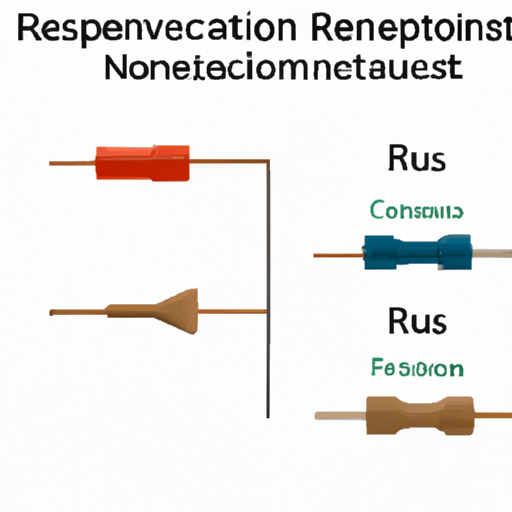Similar Recommendations for Non-Inductive Resistor Components

I. Introduction
In the world of electronics, resistors play a crucial role in controlling current flow and voltage levels. Among the various types of resistors, non-inductive resistors stand out due to their unique characteristics that make them essential in specific applications. This article aims to provide a comprehensive overview of non-inductive resistors, their types, recommended components, alternatives, and key factors to consider when selecting them.
A. Definition of Non-Inductive Resistors
Non-inductive resistors are designed to minimize inductance, which can adversely affect circuit performance, especially in high-frequency applications. Unlike standard resistors, non-inductive resistors are constructed to ensure that they do not introduce significant inductive reactance into the circuit, making them ideal for sensitive electronic applications.
B. Importance of Non-Inductive Resistors in Electronic Circuits
The importance of non-inductive resistors cannot be overstated. They are critical in applications where signal integrity is paramount, such as audio equipment, radio frequency (RF) circuits, and precision measurement devices. By minimizing inductance, these resistors help maintain signal fidelity and reduce unwanted noise, ensuring optimal performance in electronic systems.
C. Purpose of the Article
The purpose of this article is to provide recommendations and alternatives for non-inductive resistor components, helping engineers and hobbyists make informed decisions when selecting resistors for their projects.
II. Understanding Non-Inductive Resistors
A. Characteristics of Non-Inductive Resistors
1. **Low Inductance**: The primary characteristic of non-inductive resistors is their low inductance, which is achieved through specific design and construction techniques. This feature is crucial for applications that operate at high frequencies.
2. **High Stability and Reliability**: Non-inductive resistors are known for their stability over a wide range of temperatures and operating conditions. This reliability is essential in precision applications where consistent performance is required.
3. **Power Rating and Thermal Management**: Non-inductive resistors come with various power ratings, allowing them to handle different levels of power without overheating. Proper thermal management is vital to ensure longevity and performance.
B. Applications of Non-Inductive Resistors
1. **Audio Equipment**: In audio applications, non-inductive resistors are used in crossover networks and amplifiers to maintain signal integrity and prevent distortion.
2. **RF Applications**: Non-inductive resistors are essential in RF circuits, where even small amounts of inductance can lead to signal degradation and interference.
3. **Precision Measurement Devices**: These resistors are commonly used in precision measurement instruments, such as oscilloscopes and multimeters, where accuracy is critical.
III. Types of Non-Inductive Resistors
A. Wirewound Resistors
1. **Description and Construction**: Wirewound resistors are made by winding a resistive wire around a ceramic or fiberglass core. This construction allows for low inductance and high power ratings.
2. **Advantages and Disadvantages**: Wirewound resistors offer excellent stability and power handling but can be more expensive and bulkier than other types.
B. Thick Film Resistors
1. **Description and Construction**: Thick film resistors are made by applying a resistive paste onto a substrate and then firing it to create a solid film. This method allows for precise resistance values and low inductance.
2. **Advantages and Disadvantages**: They are cost-effective and suitable for mass production but may have lower power ratings compared to wirewound resistors.
C. Thin Film Resistors
1. **Description and Construction**: Thin film resistors are created by depositing a thin layer of resistive material onto a substrate. This construction provides high precision and low temperature coefficients.
2. **Advantages and Disadvantages**: Thin film resistors offer excellent performance and stability but can be more expensive than thick film options.
D. Carbon Composition Resistors
1. **Description and Construction**: Carbon composition resistors are made from a mixture of carbon and a binding material. They are known for their non-inductive properties due to their random structure.
2. **Advantages and Disadvantages**: While they are inexpensive and provide good performance, they may not be as stable or reliable as other types.
IV. Recommended Non-Inductive Resistor Components
A. Overview of Popular Brands and Models
1. **Vishay**: Vishay is a well-known manufacturer of electronic components, including a wide range of non-inductive resistors. Their products are recognized for quality and reliability.
2. **Ohmite**: Ohmite specializes in high-power resistors and offers a variety of non-inductive options suitable for demanding applications.
3. **Bourns**: Bourns provides a range of thin film and thick film resistors, known for their precision and low inductance.
B. Specific Product Recommendations
1. **Vishay Wirewound Resistors**: The Vishay WSL series offers low inductance and high power ratings, making them ideal for audio and RF applications.
2. **Ohmite Thick Film Resistors**: The Ohmite 50 series provides excellent thermal stability and low inductance, suitable for various electronic applications.
3. **Bourns Thin Film Resistors**: The Bourns 3300 series is known for its precision and low temperature coefficient, making it a great choice for measurement devices.
C. Comparison of Specifications
1. **Power Ratings**: When selecting non-inductive resistors, consider the power ratings to ensure they can handle the required load without overheating.
2. **Tolerance Levels**: Tolerance levels indicate how much the actual resistance can vary from the specified value. Choose resistors with appropriate tolerance for your application.
3. **Temperature Coefficients**: The temperature coefficient indicates how much the resistance changes with temperature. Lower coefficients are preferable for precision applications.
V. Alternatives to Non-Inductive Resistors
A. Inductive Resistors with Low Inductance
1. **Description and Use Cases**: Some inductive resistors are designed with low inductance to minimize their impact on circuit performance. They can be used in applications where non-inductive resistors are not available.
2. **Performance Comparison**: While they may not perform as well as true non-inductive resistors, low-inductance inductive resistors can be a viable alternative in certain situations.
B. Resistor Networks and Arrays
1. **Description and Benefits**: Resistor networks and arrays combine multiple resistors into a single package, providing space-saving solutions and simplified circuit design.
2. **Applications in Circuit Design**: These components are useful in applications where multiple resistances are needed, such as in voltage dividers or pull-up/pull-down configurations.
C. Custom Resistor Solutions
1. **When to Consider Custom Solutions**: In specialized applications where standard resistors do not meet requirements, custom resistor solutions can be designed to fit specific needs.
2. **Examples of Custom Resistor Applications**: Custom resistors are often used in aerospace, medical devices, and high-performance audio equipment, where precision and reliability are critical.
VI. Factors to Consider When Choosing Non-Inductive Resistors
A. Application Requirements
1. **Frequency Response**: Consider the frequency range of your application, as this will influence the type of non-inductive resistor you choose.
2. **Power Handling**: Ensure that the resistor can handle the power levels required by your circuit without overheating.
B. Environmental Considerations
1. **Temperature Range**: Select resistors that can operate within the temperature range of your application to ensure reliability.
2. **Humidity and Moisture Resistance**: In environments with high humidity, consider resistors with moisture-resistant coatings to prevent degradation.
C. Cost vs. Performance Trade-offs
When selecting non-inductive resistors, it is essential to balance cost and performance. While high-performance resistors may come at a premium, they can provide significant benefits in critical applications.
VII. Conclusion
In summary, non-inductive resistors are vital components in electronic circuits, particularly in applications requiring high stability and low inductance. Understanding the different types of non-inductive resistors, their characteristics, and suitable applications can help you make informed decisions when selecting components for your projects.
A. Summary of Key Points
- Non-inductive resistors minimize inductance, making them ideal for high-frequency and precision applications.
- Various types of non-inductive resistors, including wirewound, thick film, thin film, and carbon composition, offer different advantages and disadvantages.
- Popular brands like Vishay, Ohmite, and Bourns provide reliable non-inductive resistor options.
B. Final Recommendations for Selecting Non-Inductive Resistor Components
When choosing non-inductive resistors, consider application requirements, environmental factors, and cost-performance trade-offs. Always refer to manufacturer specifications to ensure compatibility with your circuit design.
C. Encouragement for Further Research and Exploration in Resistor Technologies
As technology continues to evolve, new resistor technologies and materials are being developed. Staying informed about advancements in resistor technology can lead to better performance and reliability in your electronic designs.
VIII. References
- Academic Journals and Articles on Resistor Technologies
- Manufacturer Specifications and Datasheets from Vishay, Ohmite, and Bourns
- Industry Standards and Guidelines for Electronic Components
By understanding the nuances of non-inductive resistors and exploring various options, you can enhance the performance and reliability of your electronic projects.
Similar Recommendations for Non-Inductive Resistor Components

I. Introduction
In the world of electronics, resistors play a crucial role in controlling current flow and voltage levels. Among the various types of resistors, non-inductive resistors stand out due to their unique characteristics that make them essential in specific applications. This article aims to provide a comprehensive overview of non-inductive resistors, their types, recommended components, alternatives, and key factors to consider when selecting them.
A. Definition of Non-Inductive Resistors
Non-inductive resistors are designed to minimize inductance, which can adversely affect circuit performance, especially in high-frequency applications. Unlike standard resistors, non-inductive resistors are constructed to ensure that they do not introduce significant inductive reactance into the circuit, making them ideal for sensitive electronic applications.
B. Importance of Non-Inductive Resistors in Electronic Circuits
The importance of non-inductive resistors cannot be overstated. They are critical in applications where signal integrity is paramount, such as audio equipment, radio frequency (RF) circuits, and precision measurement devices. By minimizing inductance, these resistors help maintain signal fidelity and reduce unwanted noise, ensuring optimal performance in electronic systems.
C. Purpose of the Article
The purpose of this article is to provide recommendations and alternatives for non-inductive resistor components, helping engineers and hobbyists make informed decisions when selecting resistors for their projects.
II. Understanding Non-Inductive Resistors
A. Characteristics of Non-Inductive Resistors
1. **Low Inductance**: The primary characteristic of non-inductive resistors is their low inductance, which is achieved through specific design and construction techniques. This feature is crucial for applications that operate at high frequencies.
2. **High Stability and Reliability**: Non-inductive resistors are known for their stability over a wide range of temperatures and operating conditions. This reliability is essential in precision applications where consistent performance is required.
3. **Power Rating and Thermal Management**: Non-inductive resistors come with various power ratings, allowing them to handle different levels of power without overheating. Proper thermal management is vital to ensure longevity and performance.
B. Applications of Non-Inductive Resistors
1. **Audio Equipment**: In audio applications, non-inductive resistors are used in crossover networks and amplifiers to maintain signal integrity and prevent distortion.
2. **RF Applications**: Non-inductive resistors are essential in RF circuits, where even small amounts of inductance can lead to signal degradation and interference.
3. **Precision Measurement Devices**: These resistors are commonly used in precision measurement instruments, such as oscilloscopes and multimeters, where accuracy is critical.
III. Types of Non-Inductive Resistors
A. Wirewound Resistors
1. **Description and Construction**: Wirewound resistors are made by winding a resistive wire around a ceramic or fiberglass core. This construction allows for low inductance and high power ratings.
2. **Advantages and Disadvantages**: Wirewound resistors offer excellent stability and power handling but can be more expensive and bulkier than other types.
B. Thick Film Resistors
1. **Description and Construction**: Thick film resistors are made by applying a resistive paste onto a substrate and then firing it to create a solid film. This method allows for precise resistance values and low inductance.
2. **Advantages and Disadvantages**: They are cost-effective and suitable for mass production but may have lower power ratings compared to wirewound resistors.
C. Thin Film Resistors
1. **Description and Construction**: Thin film resistors are created by depositing a thin layer of resistive material onto a substrate. This construction provides high precision and low temperature coefficients.
2. **Advantages and Disadvantages**: Thin film resistors offer excellent performance and stability but can be more expensive than thick film options.
D. Carbon Composition Resistors
1. **Description and Construction**: Carbon composition resistors are made from a mixture of carbon and a binding material. They are known for their non-inductive properties due to their random structure.
2. **Advantages and Disadvantages**: While they are inexpensive and provide good performance, they may not be as stable or reliable as other types.
IV. Recommended Non-Inductive Resistor Components
A. Overview of Popular Brands and Models
1. **Vishay**: Vishay is a well-known manufacturer of electronic components, including a wide range of non-inductive resistors. Their products are recognized for quality and reliability.
2. **Ohmite**: Ohmite specializes in high-power resistors and offers a variety of non-inductive options suitable for demanding applications.
3. **Bourns**: Bourns provides a range of thin film and thick film resistors, known for their precision and low inductance.
B. Specific Product Recommendations
1. **Vishay Wirewound Resistors**: The Vishay WSL series offers low inductance and high power ratings, making them ideal for audio and RF applications.
2. **Ohmite Thick Film Resistors**: The Ohmite 50 series provides excellent thermal stability and low inductance, suitable for various electronic applications.
3. **Bourns Thin Film Resistors**: The Bourns 3300 series is known for its precision and low temperature coefficient, making it a great choice for measurement devices.
C. Comparison of Specifications
1. **Power Ratings**: When selecting non-inductive resistors, consider the power ratings to ensure they can handle the required load without overheating.
2. **Tolerance Levels**: Tolerance levels indicate how much the actual resistance can vary from the specified value. Choose resistors with appropriate tolerance for your application.
3. **Temperature Coefficients**: The temperature coefficient indicates how much the resistance changes with temperature. Lower coefficients are preferable for precision applications.
V. Alternatives to Non-Inductive Resistors
A. Inductive Resistors with Low Inductance
1. **Description and Use Cases**: Some inductive resistors are designed with low inductance to minimize their impact on circuit performance. They can be used in applications where non-inductive resistors are not available.
2. **Performance Comparison**: While they may not perform as well as true non-inductive resistors, low-inductance inductive resistors can be a viable alternative in certain situations.
B. Resistor Networks and Arrays
1. **Description and Benefits**: Resistor networks and arrays combine multiple resistors into a single package, providing space-saving solutions and simplified circuit design.
2. **Applications in Circuit Design**: These components are useful in applications where multiple resistances are needed, such as in voltage dividers or pull-up/pull-down configurations.
C. Custom Resistor Solutions
1. **When to Consider Custom Solutions**: In specialized applications where standard resistors do not meet requirements, custom resistor solutions can be designed to fit specific needs.
2. **Examples of Custom Resistor Applications**: Custom resistors are often used in aerospace, medical devices, and high-performance audio equipment, where precision and reliability are critical.
VI. Factors to Consider When Choosing Non-Inductive Resistors
A. Application Requirements
1. **Frequency Response**: Consider the frequency range of your application, as this will influence the type of non-inductive resistor you choose.
2. **Power Handling**: Ensure that the resistor can handle the power levels required by your circuit without overheating.
B. Environmental Considerations
1. **Temperature Range**: Select resistors that can operate within the temperature range of your application to ensure reliability.
2. **Humidity and Moisture Resistance**: In environments with high humidity, consider resistors with moisture-resistant coatings to prevent degradation.
C. Cost vs. Performance Trade-offs
When selecting non-inductive resistors, it is essential to balance cost and performance. While high-performance resistors may come at a premium, they can provide significant benefits in critical applications.
VII. Conclusion
In summary, non-inductive resistors are vital components in electronic circuits, particularly in applications requiring high stability and low inductance. Understanding the different types of non-inductive resistors, their characteristics, and suitable applications can help you make informed decisions when selecting components for your projects.
A. Summary of Key Points
- Non-inductive resistors minimize inductance, making them ideal for high-frequency and precision applications.
- Various types of non-inductive resistors, including wirewound, thick film, thin film, and carbon composition, offer different advantages and disadvantages.
- Popular brands like Vishay, Ohmite, and Bourns provide reliable non-inductive resistor options.
B. Final Recommendations for Selecting Non-Inductive Resistor Components
When choosing non-inductive resistors, consider application requirements, environmental factors, and cost-performance trade-offs. Always refer to manufacturer specifications to ensure compatibility with your circuit design.
C. Encouragement for Further Research and Exploration in Resistor Technologies
As technology continues to evolve, new resistor technologies and materials are being developed. Staying informed about advancements in resistor technology can lead to better performance and reliability in your electronic designs.
VIII. References
- Academic Journals and Articles on Resistor Technologies
- Manufacturer Specifications and Datasheets from Vishay, Ohmite, and Bourns
- Industry Standards and Guidelines for Electronic Components
By understanding the nuances of non-inductive resistors and exploring various options, you can enhance the performance and reliability of your electronic projects.













